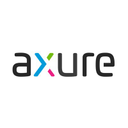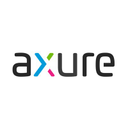Axure vs Figma (2025 Comparison)

Axure offers advanced prototyping capabilities and robust functionality for UX design. While it has a steep learning curve, its detailed wireframing tools make it a valuable asset for designers.
- Advanced prototyping capabilities
- Detailed wireframing tools
- Robust functionality for UX design
- Steep learning curve
- Higher pricing for small teams
Free plan?
NoStarting price
$25 per month per user
Figma provides real-time collaboration and an intuitive user interface, making it ideal for teams. Its extensive integration options enhance versatility, though it requires internet for full functionality.
- Real-time collaboration
- Intuitive user interface
- Extensive integration options
- Limited advanced prototyping
- Requires internet for full functionality
Free plan?
YesStarting price
$15 per month per userWhat is Axure?
Axure is a powerful prototyping tool that allows designers to create interactive wireframes and prototypes. It helps users visualize complex ideas and test user interactions before development. Axure is particularly beneficial for UX designers and product managers who need to communicate design concepts clearly and efficiently. With its robust features, Axure enables users to create detailed and dynamic prototypes, making it easier to gather feedback and iterate on designs.
What is Figma?
Figma is a collaborative interface design tool that allows teams to work together in real-time. It is widely used for designing user interfaces, creating prototypes, and collaborating on design projects. Figma's cloud-based platform makes it easy for teams to access and edit designs from anywhere, fostering seamless collaboration. With its intuitive interface and powerful features, Figma helps designers streamline their workflow and bring their creative ideas to life efficiently.
Pros and Cons of Axure vs Figma

Pros & Cons of Axure
- Axure offers advanced prototyping features that allow you to create highly interactive and detailed prototypes. This is particularly useful for complex projects where detailed interactions are crucial.
- With Axure, you have access to a wide range of wireframing tools that enable you to create detailed and precise wireframes. This is ideal for UX designers who need to communicate design concepts clearly.
- Axure provides robust functionality for UX design, making it a valuable tool for designers and product managers. Its features help streamline the design process and improve communication with stakeholders.
- Axure has a steep learning curve, which might require more time for new users to master. This can be a barrier for those who need to get started quickly.
- Axure's pricing might be on the higher side for small teams, making it less accessible for those with limited budgets. This can be a drawback for startups and small businesses.

Pros & Cons of Figma
- Figma's real-time collaboration features are unmatched, allowing teams to work together seamlessly. This enhances teamwork and improves the design process.
- Figma's user interface is clean and intuitive, making it easy to navigate and use. This is especially beneficial for beginners and those who prefer a more user-friendly experience.
- Figma offers extensive integration options with popular tools, enhancing its versatility. This makes it adaptable to various workflows and improves productivity.
- While Figma offers prototyping capabilities, it is more focused on collaborative design. This might be a limitation for those who need advanced prototyping features.
- Figma's cloud-based platform requires an internet connection for full functionality. This can be a drawback for those who need to work offline or in areas with limited connectivity.
Axure vs Figma: At A Glance
Value to Price
Axure offers a comprehensive set of features for prototyping, making it a valuable tool for UX designers. However, its pricing might be on the higher side for small teams. Figma, on the other hand, provides excellent value with its collaborative features and competitive pricing, making it a preferred choice for teams looking for cost-effective solutions.
Ease of Use
Figma is known for its user-friendly interface, making it easy for designers to get started quickly. Its intuitive design and real-time collaboration features enhance the user experience. Axure, while powerful, has a steeper learning curve, which might require more time for new users to master. Figma is better suited for those seeking an easy-to-use tool.
Functionality
Both Axure and Figma offer robust functionality for design and prototyping. Axure excels in creating detailed and interactive prototypes, while Figma shines in collaborative design and real-time editing. If you need advanced prototyping capabilities, Axure is the way to go. For collaborative design, Figma is the better choice.
Scalability
Figma's cloud-based platform allows for seamless scalability, making it ideal for growing teams. Axure also supports scalability but may require additional resources for larger projects. If your team is expanding, Figma's scalability features make it a more suitable option.
Integrations
Figma offers a wide range of integrations with popular tools, enhancing its versatility. Axure also supports integrations, but Figma's extensive library makes it more adaptable to various workflows. For teams relying on multiple tools, Figma's integration capabilities are a significant advantage.
Customer Support
Both Axure and Figma provide reliable customer support. Axure offers detailed documentation and responsive support channels. Figma also provides excellent support, with a strong community and resources. If customer support is a priority, both tools are well-equipped to assist users.
Security
Security is a crucial aspect for both Axure and Figma. Axure ensures data protection with robust security measures. Figma, being cloud-based, also prioritizes security, offering secure access and data encryption. Both tools are reliable in terms of security, making them suitable for handling sensitive design projects.
Axure vs Figma: A Detailed Breakdown of Key Features
Prototyping
Axure excels in prototyping with its advanced features, allowing you to create highly interactive and detailed prototypes. I found it particularly useful for complex projects where detailed interactions are crucial. Figma, while also offering prototyping capabilities, is more focused on collaborative design. If your primary need is advanced prototyping, Axure is the better choice. However, for collaborative design with basic prototyping, Figma is more suitable.
Collaboration
Figma's real-time collaboration features are unmatched, making it easy for teams to work together seamlessly. I love how you can see changes in real-time, which enhances teamwork. Axure offers collaboration features but lacks the real-time aspect. If collaboration is a priority, Figma is the clear winner. Axure is more suited for individual work or smaller teams.
Design Tools
Both Axure and Figma offer robust design tools. Axure provides a wide range of tools for creating detailed wireframes and prototypes. Figma, on the other hand, offers a more intuitive interface with powerful design tools that are easy to use. If you prefer a more intuitive design experience, Figma is the way to go. Axure is better for those who need advanced design capabilities.
Version Control
Figma's version control is impressive, allowing you to track changes and revert to previous versions easily. I found it very helpful for managing design iterations. Axure also offers version control, but Figma's implementation is more user-friendly. If version control is important to you, Figma is the better option. Axure is suitable for those who need basic version control features.
Cloud Access
Figma's cloud-based platform provides easy access to your designs from anywhere, which is a huge advantage for remote teams. I appreciate the convenience of accessing my work on the go. Axure, while offering cloud access, is more limited in this regard. If you need seamless cloud access, Figma is the better choice. Axure is more suited for local work.
User Interface
Figma's user interface is clean and intuitive, making it easy to navigate and use. I found it very user-friendly, especially for beginners. Axure's interface is more complex, which might require some time to get used to. If ease of use is a priority, Figma is the better option. Axure is better for those who need advanced features and are willing to invest time in learning the interface.
Pricing Comparison of Axure and Figma
We’ve compiled the pricing tables and highlighted the key features of both Axure and Figma to aid in your decision-making process. Let’s explore what each platform has to offer.

Axure Pricing Plans
- Unlimited reviewers to gather comprehensive feedback.
- Advanced prototyping for detailed design work.
- Wireframes, diagrams, and documentation for clarity.
- Unlimited projects on Cloud for seamless access.
- Revision history to track changes over time.
- Team project hosting on Cloud for shared access.
- Automatic history of check-ins with notes for transparency.
- Export any revision for version control.
- User management and single sign-on for security.
- Company domain for internal member use.
- Private or on-prem security for data protection.
- Contact us for security and licensing options.

Figma Pricing Plans
- Create up to 3 collaborative design files for team projects.
- Unlimited personal drafts for individual work and experimentation.
- Basic file inspection to review and analyze design elements.
- Free access for students and educators to support learning.
- Team libraries for shared design resources and assets.
- Advanced prototyping features for interactive design testing.
- Unlimited version history to track design changes over time.
- Shared and private projects for organized team collaboration.
- Design system analytics to measure design system usage.
- Branching and merging for collaborative design workflows.
- Centralized file management for efficient resource handling.
- Single sign-on for secure and easy access management.
- Sync variables to code via REST API for seamless integration.
- Dedicated workspaces for teams to enhance collaboration.
- Guest access controls for secure external collaboration.
- Idle session timeout for enhanced security measures.
Our Rating Methodology
We thoroughly test each design tool, evaluating key features like ease of use, functionality, and scalability. We also analyze user reviews to ensure our recommendations fit your needs. Each of the seven evaluation factors is weighted by importance to provide an accurate final rating, helping you avoid poor-quality tools and make informed decisions.
Axure or Figma: Which One Matches Your Business Needs?
Choose Axure If You Need ...
- Advanced prototyping needs
If you require advanced prototyping capabilities for complex projects, Axure is the better choice. Its detailed wireframing tools and robust functionality make it ideal for UX designers who need to create highly interactive prototypes.
- Detailed wireframing
If you need detailed wireframing tools to communicate design concepts clearly, Axure is the way to go. Its comprehensive set of features helps streamline the design process and improve communication with stakeholders.
Choose Figma If You Need ...
- Real-time collaboration
If you need real-time collaboration features for seamless teamwork, Figma is the better option. Its cloud-based platform allows teams to work together efficiently, making it ideal for collaborative design projects.
- Intuitive design experience
If you prefer an intuitive design experience with a user-friendly interface, Figma is the way to go. Its clean and easy-to-navigate interface makes it suitable for beginners and those who prioritize ease of use.
Frequently Asked Questions
 Which tool is better for advanced prototyping?
Which tool is better for advanced prototyping?
 Which tool offers better real-time collaboration?
Which tool offers better real-time collaboration?
 Which tool is more user-friendly?
Which tool is more user-friendly?
 Which tool provides better value for money?
Which tool provides better value for money?
 Which tool is better for scalability?
Which tool is better for scalability?
 Which tool offers more integrations?
Which tool offers more integrations?

Anastasia Belyh
Anastasia Belyh is a senior tech writer with over 15 years of experience in marketing, sales, and business software. Having worked in investment banking, management consulting, and founded multiple companies, her in-depth knowledge and hands-on expertise make her software reviews authoritative, trustworthy, and highly practical for business decision-makers.



